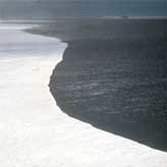About Sea Ice
What is Sea Ice?
Each winter the surface of a large area of the Southern Ocean freezes, forming a sea ice cover that surrounds Antarctica. This ice, with its expansive maximum extent and large annual variability has a major influence on the global climate system. A cover of sea ice affects the interaction between the ocean and the atmosphere by drastically modifying the transfer of heat, mass and momentum. This in turn impacts on the circulation of both the atmosphere and ocean.
The ice acts as a physical barrier to the exchange of gases (such as oxygen, carbon dioxide and water vapour), and as an insulating blanket between the relatively warm ocean and colder atmosphere. During winter when the temperature gradients between the surface ocean (whose temperature never falls below -1.9°C) and the atmosphere are greatest, the loss of heat to the atmosphere can be up to two orders of magnitude smaller over a sea ice cover than open ocean. With its high albedo (the fraction of incident solar radiation that is reflected by the surface) the ice and its snow cover also reduces the amount of incoming solar radiation absorbed at the ocean surface by reflecting much of it back to space. The transfer of momentum from the atmosphere to the ocean, which influences ocean currents, is also modified by the presence of ice. Sea ice is considerably less salty than sea water, and salt rejected from the ice structure during its formation and growth increases the salinity and density of the underlying water. This may induce deep vertical convection that contributes to the upwelling of nutrients and to the overall thermohaline circulation (water movement driven by salinity and temperature gradients) of the ocean. Conversely when the ice melts in spring it releases fresher water, forming a stable low salinity surface layer.
The Antarctic sea ice zone is a habitat for many species of biota. Many algal communities reside within or under the ice, and algal blooms occur in the stable freshwater "lens" that forms as the ice edge retreats in the summer. Large quantities of krill feed on the phytoplankton that in some way depend on the sea ice, and in turn provide a major food source for larger animals such as whales, seals and penguins. The sea ice is also used as a breeding platform by some seals and penguins, and may provide a refuge from predators.
Even in winter only a small fraction of sea ice close to the Antarctic continent occurs as a continuous and uniform sheet. This ice, called "land fast" ice, is pinned to the coast and does not move. The majority of the ice occurs in a wide band around the continent and is referred to as "pack ice". This is a region of highly variable ice conditions, including broken pieces (floes) with a range of sizes, ages and thicknesses, present in varying concentrations. The pack is highly mobile, moving with the wind and currents, with its characteristics constantly changing. There is frequently some open water (leads) between the floes and it is common to see ice at various stages of development present in the same area. This is the result of the dynamic nature of the pack, with the thickness of floes increasing through rafting and ridging as they interact, and new open water areas constantly being created allowing new ice to form.
The degree to which sea ice affects ocean-atmosphere interactions depends on the ice extent and its thickness distribution. The thickness distribution describes the nature of the surface within the pack in terms of the concentration (the fraction of surface area covered) of different ice thickness categories. While sea ice influences the ocean and the atmosphere, the distribution and characteristics of the ice are, in turn, forced by atmospheric and oceanic variables such as temperature, wind, ocean currents, and swell. Thus the ocean, sea ice and atmosphere form a complex interactive system.

